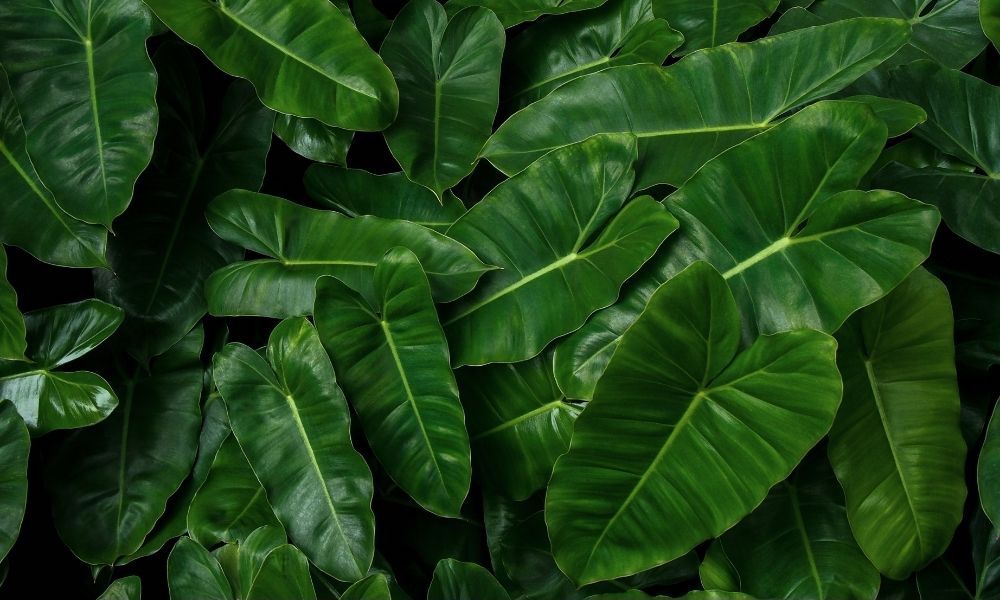Philodendron
Keeping a philodendron as a house plant is a great way to trick your guests into thinking you have a magical green thumb (even if you don’t). This beautiful, large-leaved foliage plant is resilient and adaptive, making its care easy-peasy. Let’s take a look at what these types of plants have to offer!
What is a Philodendron Plant?
The philodendron, which is actually its scientific and common name, originally hails from Central and South American regions. There are two basic varieties which are vining and non-vining. The vining type needs something to climb, like a trellis, and the non-vining varieties grow straight upward on their own.
Both options grow large, flat, glossy green leaves in the shape of teardrops. Their hardy stems are smooth to the touch, which helps to distinguish the philodendron from the pothos plant. While the two plants are quite similar, pothos’ stems are grooved and rougher to the touch.
- Plant Size – Depending on what type you have, these plants can grow anywhere between one and 20 feet tall! The vining philodendron grows long, leafy vines that continue to climb as long as they have something to cling to. The non-vining variety is typically shorter and often grows wider than it does tall.
- Light – These plants thrive in bright, indirect light. They’re used to the partial sunlight under the canopies of tropical rainforests. A north, south, or west-facing window is the best place for philodendrons – that way, they’ll get mostly indirect light and only a bit of direct sunlight.
- Watering – Philodendrons enjoy moderately damp soil at all times. It’s best to wait until the top inch of their soil has dried before watering. Try not to overwater, as that can lead to root rot. Underwatering can cause several leaves to turn yellow suddenly, though a couple of yellow leaves are normal.
- Temperature/Humidity – These types of plants flourish in warm temperatures around 65 to 80°. Do your best never to keep your philodendron in temperatures below 55°. They also prefer humid conditions, slightly above the average household humidity (which is ≈ 40%). To help your plant get the moisture it needs, try misting the leaves every few days.

Why Choose a Philodendron Plant for Your Home?
The philodendron excels at purifying the air in small spaces. By adding one or two to your home, you’re not only adding tropical decor, but you’re also cleaning the air you breathe! Philodendron care is piece of cake, AND they care for you in return. It’s a win-win!
Philodendron Plant Family Relatives
The philodendron family boasts hundreds of members, including the widely admired Monstera deliciosa (sometimes called a swiss cheese plant because of the massive holes in the leaves). Some of the other common varieties include:
- Philodendron ‘Brasil’ – This vibrant plant becomes variegated (multi-colored) under the right conditions. The ‘Brasil’ tolerates brighter light than other kinds and with the right amount of sun exposure, it develops bright yellow stripes down the middles of its leaves.
- Philodendron Brandtianum – This magnificent variation is beautifully variegated with silvery bands along its wide leaves. Unlike the ‘Brasil’ variety, the Brandtianum’s variegation comes out in lower light settings.
- Philodendron Hastatum – This stunning philodendron variety grows light green, almost sage-colored leaves that can grow up to NINE INCHES wide and TWO FEET long. Sadly, the Hastatum plant is endangered in its native Brazil, but it’s so popular as a houseplant that enthusiasts have saved it from endangerment!
Final Thoughts
When you stroll through your local plant nursery, you’re likely passing by several different varieties of the philodendron as you browse. Because they bring simple, natural beauty to homes, they have become incredibly popular houseplants. And with such simple care, any person can own one, no matter how busy or forgetful you are!